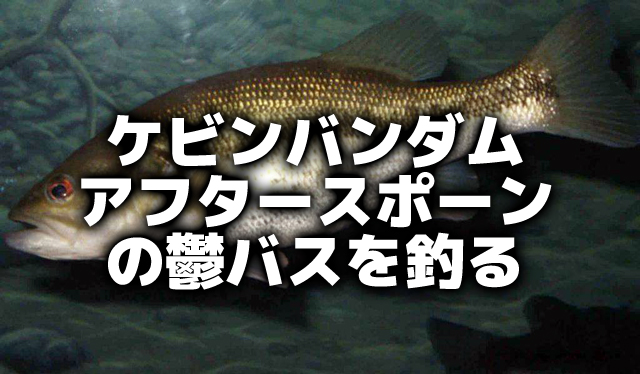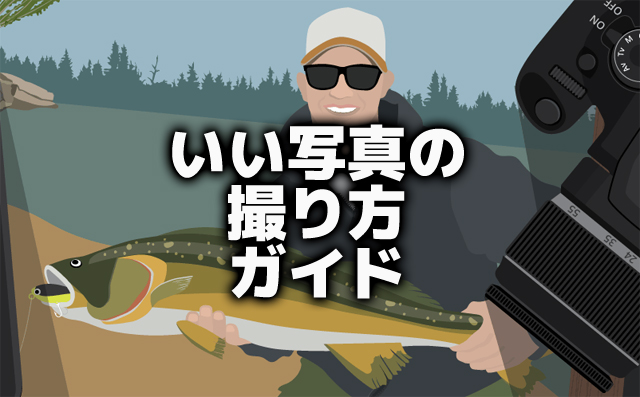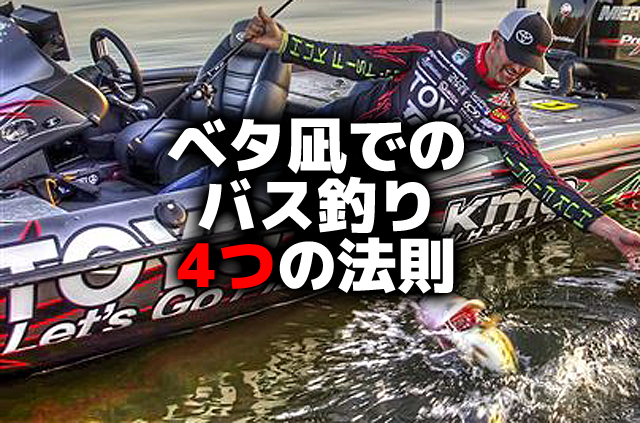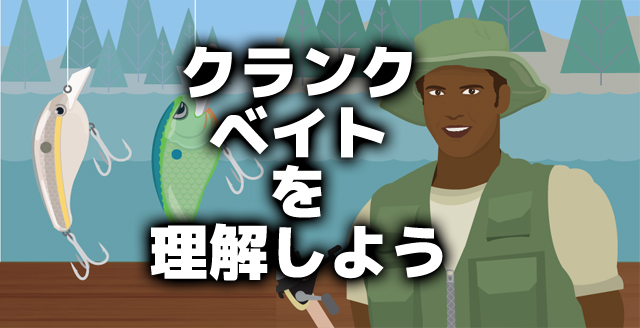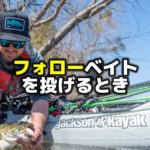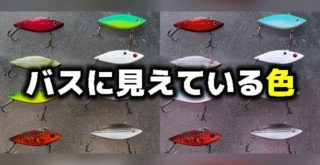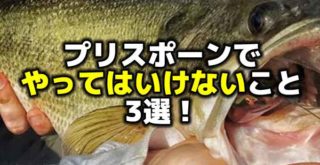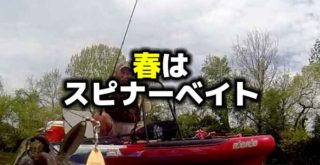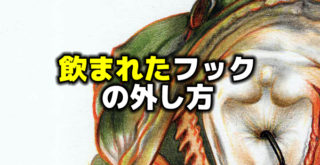ビッグバスエリアの見つけ方と攻め方
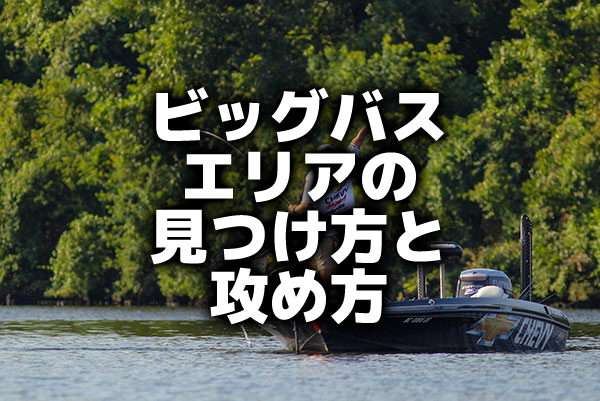
Photo by scout.com
こんにちは!店長の小山です!
本日は海外サイトより、”Finding and Managing Big Bass Areas”という記事を引用してご紹介いたします。
引用先:scout.com”Finding and Managing Big Bass Areas”By WALKER SMITH 08/29/2013(海外サイトです)
皆さんがよく行くお気に入りのフィールドには、「ここで釣れれば、60近いはず」みたいな確信の持てるような、自分だけのビッグバスポイントというものはありますでしょうか?
経験豊富なアングラーさんなら持っているかもしれませんが、すべてのアングラーさんが持ってるものではないのではないでしょうか。
私の場合も、釣れるポイントは知っていても、釣れるのがビッグバスかどうかまではわからないという感じです。釣りをするときはいつでもビッグがいるという妄想で釣りしますけども(笑)、正直言ってそんなスイートスポットを見つけたり、自己記録バスを釣るなんて、一生のうちにあと何回あるかどうかだと思います。
そこで、この記事です。
FLWのバスプロ、ブライアン・スリフト氏は、2013年のフォレストウッドカップ(レッドリバー)で他の選手が何キロメートルにもわたるエリアを釣っていたのに対し(川なので検索範囲が長い)、彼はわずか45メートルのバンクを釣り続け、3位に入ったことで、記者たちは他の選手と違うアプローチの考え方を発見させられたようです。
スリフト氏によると、ビッグバスのいるハニースポットの見つけ方として、誰にでもできるちょっとしたことがあるそうです。
ぜひ読んでみましょう。
ビッグバスの必要条件
If big bass were easy to catch, we’d all be touring professionals. Unfortunately for us, they don’t get big by being dumb. Thrift has noticed, however, that there are 2 environmental requirements areas must have in order to host the bass of a lifetime.
“If I’m looking for an area that will hold multiple kicker fish, bait and adjacent deep water are absolute necessities,” Thrift said. “Deep water makes giant bass feel secure and they will seek areas that provide quick access to an easy meal.”
Whether it’s the steep side of a point, a nearby creek channel swing or a river bend, big bass congregate in these areas. While they can be inactive and fairly unmolested in deep water, these areas allow them to slide up and feed without exerting much effort. Just as many of us will sit as close as possible to a restaurant’s buffet, big bass behave in the same manner.
もしビッグバスをキャッチするのが簡単なら、私たちは全員バスプロになるでしょう。 残念なことに、私たちのために愚かなビッグバスが存在することはありません。 しかし、自己記録級のバスを迎え入れるためには2つの環境要件が必要であることに気づきました。
「複数のキッカーフィッシュがいるエリアを探しているなら、ベイトと隣接するディープは絶対必要です。 ディープは、巨大なバスに安心感をもたらし、そして彼らは簡単な食事にすばやくアクセスできる場所を探しています」
それが岬の急な側面、クリークチャンネルや川の曲がり角の近くかどうかにかかわらず、これらのエリアではビッグバスが集まります。 彼らはディープで不活性だったり、ボーっとしているものですが、こういったエリアは多くの努力をせずに移動してフィーディングことができます。 私たちの多くがレストランのビュッフェに可能な限り接近するように、ビッグバスは同じように動きます。
タイミングが重要
Most anglers target specific pieces of cover and structure when searching for big bass, but Thrift has an entirely different train of thought. He most often notices the biggest bass keeping their distance from these areas.
“True giants—like 8 and 10-pounders—don’t sit on structure very much,” Thrift said. “They’re usually in the area, but the only time they’ll actually pull onto specific structure or cover is when they’re actively feeding. This is why castable umbrella rigs have been producing so many giant bass—they’ve given anglers a way to effectively target these suspended, big bass.”
Fishing for suspended bass is difficult, so Thrift would rather target these big bass when they’re most gullible during their small feeding periods. In order to do this, he believes timing is everything.
“I think big bass stray away from competition, which is why you rarely see schools of 6-pounders,” Thrift said. “I catch more kicker fish 30 to 40 feet away from brush piles than I do inside of them. So when they move up onto more predictable cover and structure to feed, you’ve got to be there waiting for them.”
We witnessed Bryan using this game plan at the Red River. He would only fish his most productive area for 10 or 15 minutes, but that’s all he needed to get a feel for the situation.
“You’ve got to be persistent and keep hitting the area,” Thrift said. “More often than not, it will only take 15 minutes to catch a giant if they’re feeding. If it takes longer than that, your timing isn’t right and you should try again later.”
ほとんどの釣り人はビッグバスを探すときに特定のカバーとストラクチャーを対象としますが、スリフト氏は全く異なる思考を持ちます。彼はこれらのエリアからは距離を置く最大級のバスがいることに気づいています。
「まさに巨人のような8ポンド,10ポンドのバスたちは、ストラクチャーにはいません。 彼らは通常このエリアにいるにはいるのですが、実際に特定のストラクチャーやカバーにいる時間は、唯一積極的に食事をしているときだけです。これがアラバマリグで多くの巨大なバスが釣れる理由です。これにより釣り人にサスペンドビッグバスを効果的に狙う方法を与えられました。」
サスペンドバスを釣るのは難しいので、わずかなフィーディングタイム中、彼らが最も騙されやすいときに、これらのビッグバスを対象にしたいのです。これを行うためには、彼はタイミングがすべてであると考えています。
「私はビッグバスは競争から避けていると思います。理由は、2キロ後半のバスの群れを見ることなどめったにないからです」とスリフト氏は話す。 「私はキッカーフィッシュをオダから9〜12メートルも離れたところで、オダの中よりも多くキャッチしています。だから彼らがフィーディングするであろうストラクチャーへ行ってしまうと、彼らが来るのを待っていなければならなくなるのです」
私たちは、レッドリバーでこのゲームプランを行っているスリフト氏を目撃しました。彼は最もよさそうな場所を10分から15分しか釣りをしませんが、状況に気づくためにはそれで必要充分なのです。
スリフト氏は、「あなたはずっとそのエリアにいて、投げ続けなければならないと思いますが、」とスリフト氏は続けます。 「大抵、ジャイアントバスがフィーディングしているならば、釣るのに15分しかかかりません。それよりも時間がかかったら、そのタイミングは正しくないと判断し、後で入り直すべきです。」
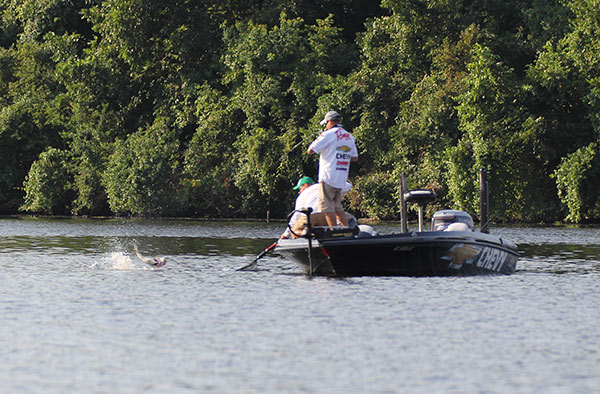
Photo by scout.com
何度も入り直す
If you’ve found an area with a large population of bait and deep water nearby, don’t give up on it too easily. As stated earlier, big bass don’t feed all day, so an hour can make a world of difference.
“If I catch 2 or 3 good ones and it shuts down shortly after, I’ll come back every hour throughout the day,” Thrift said. “You can definitely over-fish big bass areas and really mess up an otherwise perfect spot. You need to let your best areas rest without forcing the issue.”
ディープの近くにベイトの大集団のいるエリアを見つけた場合は、簡単にあきらめないでください。 先に述べたように、ビッグバスは一日中食べているわけではないので、1時間もすればまた状況も変わってきます。
「2〜3本のナイスバスを釣ったらすぐにやめ、その日はそこへ1時間ごとに戻ってくるようにします」とスリフト氏は語った。 「当然、ビッグバスエリアで釣れ過ぎるはずですが、そうならなければその完璧なスポットを潰すことにもなります。 そうなる前にその最高の場所を休ませる必要があります。」
フィネスフィッシングも忘れずに
When first approaching a big bass area, Thrift likes to start by throwing reaction baits in order to catch the most aggressive fish. He warns, however, that this approach can often hurt more than it helps.
“Usually I try to start with reaction baits, but you’ve got to be careful with it,” Thrift said. “Sometimes catching a bunch of random ‘stragglers’ can lead you astray and get you off the school. This approach can make it tough to pinpoint the sweet spot.”
After a short stint with reaction baits, you’ll often see Thrift break out a shaky head. Although it’s not necessarily billed as a big fish technique, his reasoning makes a lot of sense.
“I can’t count how many 6 and 7-pounders I’ve caught on a shaky head,” Thrift said. “I don’t mind playing the numbers game. In my opinion, the more bites I can get in a single day, the better chance I have of running across a giant. You may catch some peanuts, but your next cast could be the kicker you’ve been waiting for.”
最初にビッグバスエリアに近づいたとき、スリフトは最もアグレッシブなバスを捕まえるためにリアクションベイトを投げることから始めます。しかし彼は、このアプローチはしばしばそれが役立つどころか裏目に出ることがあると警告しています。
「通常、私はリアクションベイトから始めようとしますが、あなたはそれに注意する必要があります」とスリフト氏は述べています。 「群れの中にいるビッグワンを「まぐれ的」に釣ってしまうことは、時にあなたを惑わせて、(まだ釣れるのにポイントを休ませようとして)その群れから離れさせてしまうことがあります。このアプローチは、スイートスポットを特定するのが難しくなる可能性があります。」
リアクションベイトを少しだけ投げた後、スリフトはよくジグヘッドリグを取り出します。それは必ずしもビッグフィッシュ用のテクニックとして確立されているわけではありませんが、彼の推論はかなり意味があります。
「私は、ジグヘッドで2キロ後半から3キロフィッシュを数え切れないほど釣りました。 「博打をしようとは思いません。私の意見では、1日に得るバイトが多いほど、ジャイアントバスを釣るより良い機会になります。豆バスが来るかもしれませんが、次のキャストではあなたが待っていたキッカーかもしれません。」
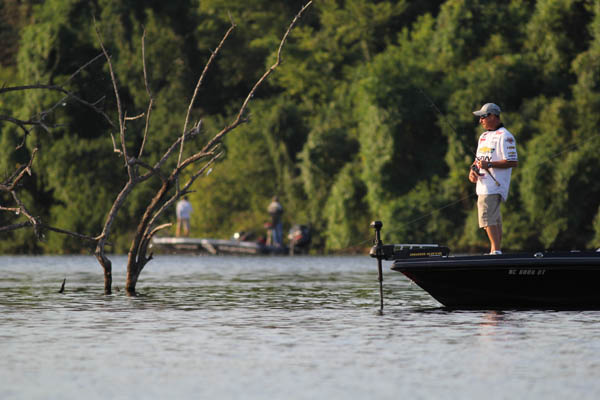
Photo by scout.com
思ったことをやる
Fishing for big bass isn’t a science and it takes years, or even decades, to master. Even if he’s convinced the bass are in a specific pattern, Thrift always takes time to try something totally different.
“It doesn’t matter what lake you’re fishing—there will always be big bass doing something they’re not supposed to be doing,” Thrift said. “If you’re catching average-sized fish on points, try to make your way into some really skinny water or vice versa. If you can find these rogue big bass, you’re going to do well in any tournament because you’ll have them to yourself.”
Thrift proved this point at the 2013 Forrest Wood Cup. While the majority of anglers were trudging through shallow, backwater slews, he spent most of the day with his boat sitting in 20 feet of water. This unique pattern led him to a third-place finish and a $60,000 payday.
ビッグバスの釣りは科学ではなく、極めるのに何年も何十年もかかります。 たとえバスがあるパターンでいると確信していても、スリフト氏はいつも時間をかけてまったく異なるものを試します。
「釣っている湖がどこであろうと関係なく、誰もがやっていないことをやっていると、よくビッグバスがきます。アベレージサイズのバスを岬で釣っているなら、今度は狭い場所で、あるいはその逆をやってみてください。 これらの特異なビッグバスを見つけることができれば、あなたはもうマスターしているので、どんなトーナメントでもうまくいくでしょう。」
スリフト氏は2013年のフォレスト・ウッドカップで、この主張を証明しました。 大部分の釣り人は、シャローやバックウォーターの釣りで入賞してきたが、水深6メートルにボートをつけて一日を過ごしました。 この異質なパターンは彼に3位フィニッシュと$ 60,000(約650万円)の賞金をもたらしました。
キャスティング方向に細心の注意を払う
Thrift has become a big believer in precise casting angles when fishing big bass areas. He’ll typically start fishing 150 yards from his primary spot to increase his stealth and promote proper casting angles.
“There’s always going to be that ‘magic cast’ when you’re fishing an area where the giants live,” Thrift said. “In many situations, if you miss the sweet spot by a few inches, you won’t get a single bite. If I know there are big ones in the area, I make sure to cast from 5 or 6 directions and throw 10 to 15 baits on it. You can’t leave a single stone unturned.”
ビッグバスエリアを釣るときスリフト氏は、正確なキャスティング角度を大切にしています。 彼は通常、秘密のポイントを隠すためと、適切なキャスティング角度を見つけるために、最重要ポイントから130メートル離れたところから釣りを開始します。
「ジャイアントバスがいるエリアを釣っているときはいつも「魔法のキャスト」が存在します」とスリフト氏は語った。 「多くの状況で、スイートスポットを数センチ外すと、1回のバイトもきません。 私がそのエリアにビッグバスがいることを知っているなら、5から6の方向からキャストし、10から15回ルアーを投げます。 あなたは隅々まで探れていないのです。」
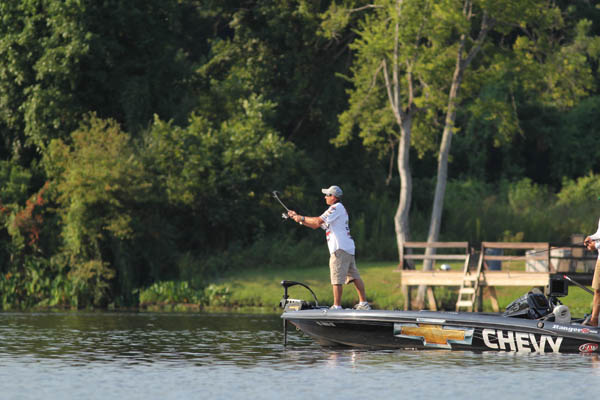
Photo by scout.com
いかがでしたか。
自己記録のバスを狙うような釣りをするときのイメージと釣り上げる可能性を膨らませることができたでしょうか。
そのフィールドの最大級のバスが釣れたという話を聞いたとき、「やっぱりあそこのポイントで釣れたか」という場合と、「えっ、そんなとこで釣れたの!?」という場合がありますよね。
この記事のやり方は、「えっそんなところで」狙いのやり方だと思いますが、初めに大きなバスを釣ってくる人って大体このタイプの人ですよね。それからそのポイントや釣り方が定番になったりするんですよね。
自分がその最初のひとりになるのはすごく勇気がいることですが、世界記録や日本記録やフィールド記録ではなく、自己記録狙いということであればそうでもありません。
少し勇気を出して、いつもとちょっと違ったやり方をやったり、信じたポイントにいつもより頻繁に入り直してみれば良いのかもしれませんね!
トーナメントで勝つことが目的でなくても、ぜひ自分だけのビッグフィッシュパターンを作ってみてください!
それでは、また。
毎度ありがとうございます!





